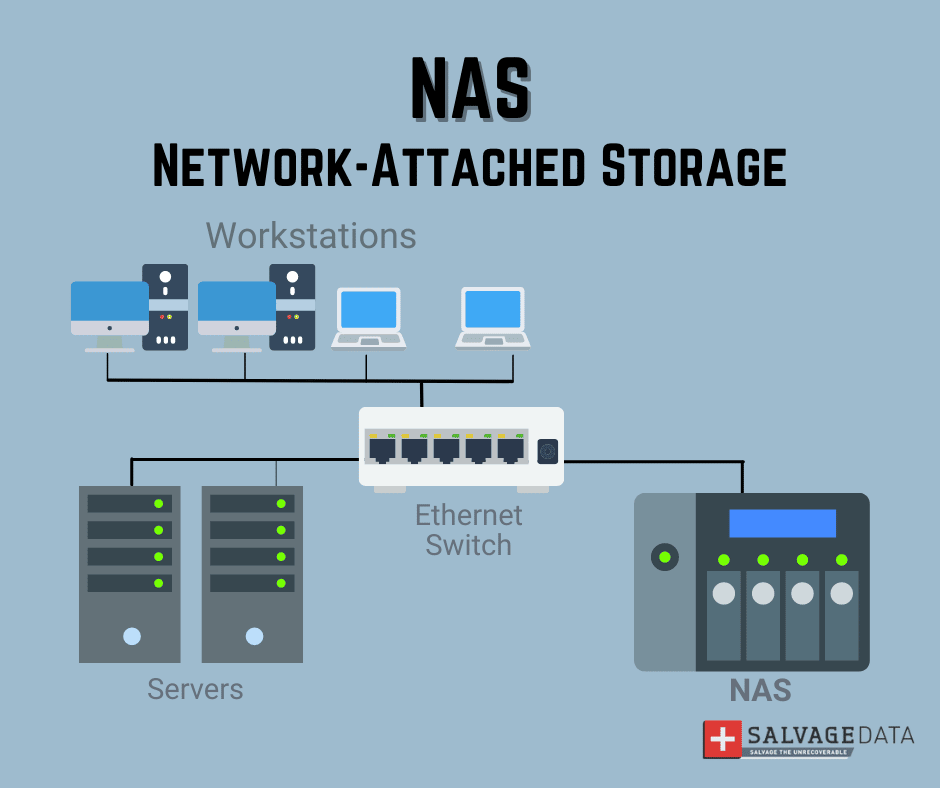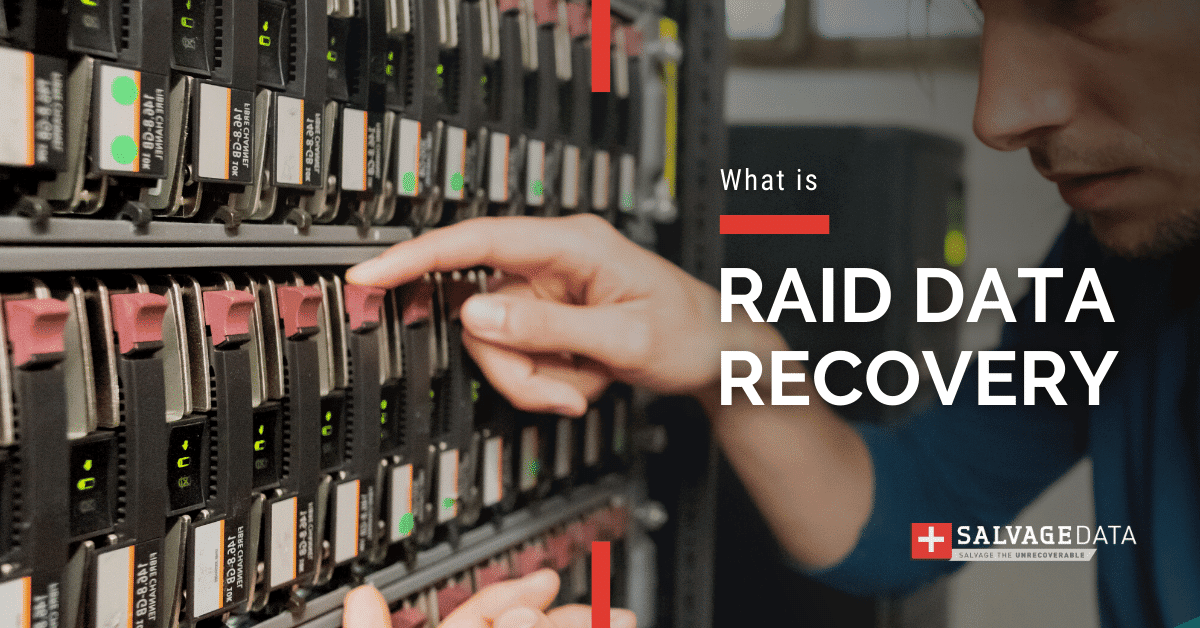Recent Articles
How To Recover Overwritten Files
The Snowflake Data Breach: A Comprehensive Overview
Mac Not Recognizing External Hard Drive: Quick Fix Solutions
How Multi-Cloud Backup Solutions Can Prevent Data Disasters
Capibara Ransomware: What is it & How to Remove
What Should a Company Do After a Data Breach: The Ticketmaster Incident
Secles Ransomware: Removal Guide
What To Do When Your Chromebook Freezes
How to Create Hyper-V Backup
What Is The Best Data Recovery Software For PC

I think there's an issue with my storage device, but I'm not sure Start a free evaluation →
I need help getting my data back right now Call now (800) 972-3282
NAS devices are designed to handle data storage and file-sharing requests, providing fast, secure, and reliable services to private networks.
Network-attached storage (NAS) is a specialized file-dedicated storage device that makes data continuously available for businesses to collaborate over a network.
In today’s digital world, understanding what NAS is and how it can benefit your business is essential to maximize efficiency and productivity.
What is network-attached storage used for
NAS is used in businesses to store and share data within a network.
The data stored on the NAS can be accessed easily by users on the same network, allowing for faster collaboration and improved communication among teams.
With the right setup, multiple users can access and edit shared files simultaneously. This makes it easier for organizations to manage their documents, photos, music, videos, and other forms of digital media.
Businesses that handle a large amount of data can’t send it daily to their cloud storage. NAS is one type of storage device that helps manage, store, share, and keep all this data secure.
Among the uses a company can have for NAS are:
- File storage and sharing
- Store images and videos that require frequent access
- Creation of an internal printing repository
- Streamline the data backup and disaster recovery
- Creation of active data archives
- Host virtual desktop infrastructure
- Test and develop web-based and server-side web applications
Some of the best NAS manufacturers include QNAP, D-Link, Linksys, Netgear, and Zyxel. If you’re looking specifically for the best QNAP NAS options, then check out our article with the pros and cons of each model.
How does NAS work
NAS devices are connected to a computer network via Ethernet cables or wireless connections. However, an Ethernet cable is more recommendable for businesses for its security (unique IP address), and the cable is also part of the NAS structure.
Pro tip: Learn more about NAS vs. SAN vs. DAS for a RAID storage system.

Once connected, the device appears as an additional drive on each user’s machine. Users can then transfer files from their computers to the NAS device using Communication Protocols and File Formatting Protocols. The NAS device then stores the files, allowing all users on the network to access them.
Communication protocols
You can have your network running using different transfer protocols. The most common is through internet protocol (IP) and transmission control protocol (TCP).
The IP receives the address to send file data and TCP delivers it by combining it into packets and sending the packets through the network.
File formatting protocols
You can use NAS with different operating systems (OS), such as Windows, Linux, or Unix. And each of them will access the files on NAS devices using their native file format.
To make it possible, the network-attached storage will format the files using:
- Network File Systems (NFS): Linux and Unix
- Server Message Blocks (SMB): Windows
- Apple Filing Protocol (AFP): Apple macOS
What are the components of a NAS device
NAS devices comprise four main components: a storage drive, a networking interface, a central processing unit (CPU), and an operating system.
The storage drive stores the data, while the operating system controls how the device accesses and manages that data.
NAS devices can have from two to five physical storage drives (hard drives). These drives provide storage capacity as well as redundancy.
The networking interface connects many computers to the NAS using an Ethernet cable or Wi-Fi. Also, some NAS devices have USB ports for this connection.
NAS central processing unit reads and writes the data and manages multiple users. Also, it can integrate the NAS with the cloud, if it’s the case.
Most NAS devices also include software such as web servers, media streaming services, and backup solutions to further increase their functionality.
How can businesses benefit from using a NAS device
- Using a NAS device eliminates the need for multiple hard drives and simplifies data storage and retrieval operations. This reduces the time and costs associated with maintaining physical hard drives, as well as provides an extra layer of security for backing-up data.
- NAS devices offer compatibility with multiple operating systems (OS), making it easier for businesses to share information between networks regardless of what OS each machine is running.
- NAS devices are a solution for businesses looking to streamline data storage and retrieval operations while enhancing collaboration among teams. By leveraging the power of a NAS device, businesses can maximize efficiency, reduce costs, and improve overall productivity.
- On-premises NAS solutions also offer a simpler way for businesses to manage and control their data. Businesses using an on-premises NAS device can store, share, and access data without relying on third-party cloud storage solutions. This makes it easier to keep data secure, as well as ensure that important information is always available when needed.
How can businesses use NAS for improved efficiency
Businesses can use NAS devices to improve file collaboration and communication between teams.
By using a centralized shared storage solution, employees can work together on projects more efficiently without having to constantly transfer files back and forth.
Businesses have greater control over their data security than they would with traditional public cloud solutions when hosting their own private cloud on the NAS device.
Finally, businesses can use NAS devices to back up their data in a secure and reliable manner. By setting up automated backups for the NAS device, businesses can ensure their important data is always safe and available for recovery in the event of an emergency.
Network-attached storage offers many advantages for businesses looking to maximize efficiency and productivity. It provides fast, secure file-sharing services with robust security features that make it an ideal solution for any organization seeking greater control over its data management system.
With the right set-up, built specifically for your needs, your business can benefit from using NAS technology.
If your NAS has room for more than one hard drive, you can use our Raid Calculator and set up your RAID based on your business’s needs.
How to protect data on NAS devices
Businesses should also take measures to protect the data stored on their NAS devices.
This includes setting up a user authentication system and encrypting data at rest with a reliable encryption algorithm. Businesses should ensure that they have access to control in place to secure their data from unauthorized users.
Having a disaster recovery plan in place is also essential for businesses looking to protect their data from unforeseen disasters or system failures. This includes having an up-to-date backup of all important data, as well as a server recovery plan and procedures in place for what to do in the event of a data loss incident or system failure.
Businesses can ensure that their information is secure and available whenever it’s needed by following these steps.
TL; DR: Network-Attached Storage (NAS) provides businesses with an efficient way to store, share, and access data over private networks. By leveraging the power of NAS devices, businesses can reduce costs, improve productivity, and gain greater control over their digital assets. Taking measures such as setting up user authentication and having a disaster recovery plan in place can help businesses protect their data from unauthorized users and unforeseen disasters. With the right set-up, NAS technology can offer many benefits for businesses looking to maximize efficiency and collaboration.
In case of NAS data loss, you can call SalvageData recovery experts 24/7 or open a help request for emergency recovery.













